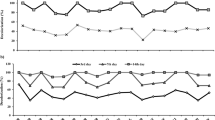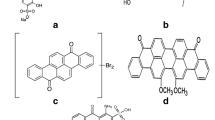Abstract
Phytoremediation provides an ecofriendly alternative for the treatment of pollutants like textile dyes. The purpose of this study was to explore phytoremediation potential of Petunia grandiflora Juss. by using its wild as well as tissue-cultured plantlets to decolorize Brilliant Blue G (BBG) dye, a sample of dye mixture and a real textile effluent. In vitro cultures of P. grandiflora were obtained by seed culture method. The decolorization experiments were carried out using wild as well as tissue-cultured plants independently. The enzymatic analysis of the plant roots was performed before and after decolorization of BBG. Metabolites formed after dye degradation were analyzed using UV–vis spectroscopy, high-performance liquid chromatography, Fourier transform infrared spectroscopy, and gas chromatography–mass spectrometry. Phytotoxicity studies were performed. Characterization of dye mixture and textile effluent was also studied. The wild and tissue-cultured plants of P. grandiflora showed the decolorized BBG up to 86 %. Significant increase in the activities of lignin peroxidase, laccase, NADH-2,6-dichlorophenol-indophenol reductase, and tyrosinase was found in the roots of the plants. Three metabolites of BBG were identified as 3-{[ethyl(phenyl)amino]methyl}benzenesulfonic acid, 3-{[methyl (phenyl)amino]methyl}benzenesulfonic amino acid, and sodium-3-[(cyclohexa-2,5-dien-1-ylideneamino)methyl]benzenesulfonate. Textile effluent sample and a synthetic mixture of dyes were also decolorized by P. grandiflora. Phytotoxicity test revealed the nontoxic nature of metabolites. P. grandiflora showed the potential to decolorize and degrade BBG to nontoxic metabolites. The plant has efficiently treated a sample of dye mixture and textile effluent.




Similar content being viewed by others
References
Ali I, Gupta VK (2007) Advances in water treatment by adsorption technology. Nat Protoc 1:2661–2667
APHA (1998) Standard methods for the examination of water and wastewater, 20th edn. American Public Health Association, Washington, DC
Bae JS, Freeman HS (2005) Aquatic toxicity evaluation of copper-complexed direct dyes to the Daphnia magna. Dyes Pigments 73:126–132
Carias C, Novais J, Martins-Dias S (2007) Phragmites australis peroxidases role in the degradation of an azo dye. Water Sci Technol 56:263–269
Gerhardt KE, Huang XD, Glick BR, Greenberg BM (2009) Phytoremediation and rhizoremediation of organic soil contaminants: potential and challenges. Plant Sci 176:20–30
Gupta VK, Ali I (2008) Removal of endosulfan and methoxychlor from water on carbon slurry. Environ Sci Technol 42:766–770
Gupta VK, Rastogi A (2008a) Biosorption of lead(II) from aqueous solutions by non-living algal biomass Oedogonium sp. and Nostoc sp.—a comparative study. Colloids Surf B 64:170–178
Gupta VK, Rastogi A (2008b) Sorption and desorption studies of chromium (VI) from nonviable cyanobacterium Nostoc muscorum biomass. J Hazard Mater 154:347–354
Gupta VK, Rastogi A (2008c) Equilibrium and kinetic modelling of cadmium (II) biosorption by nonliving algal biomass Oedogonium sp. from aqueous phase. J Hazard Mater 153:759–766
Gupta VK, Rastogi A (2009) Biosorption of hexavalent chromium by raw and acid-treated green alga Oedogonium hatei from aqueous solutions. J Hazard Mater 163:396–402
Gupta VK, Sharma S (2003) Removal of zinc from aqueous solutions using bagasse fly ash—a low cost adsorbent. Ind Eng Chem Res 42:6619–6624
Gupta VK, Rastogi A, Dwivedi MK, Mohan D (1997) Process development for the removal of zinc and cadmium from wastewater using slag—a blast furnace waste material. Sep Sci Technol 32:2883–2912
Gupta VK, Mohan D, Sharma S (1998) Removal of lead from wastewater using bagasse fly ash—a sugar industry waste material. Sep Sci Technol 33:1331–1343
Gupta VK, Srivastava SK, Tyagi R (2000) Design parameters for the treatment of phenolic wastes by carbon columns (obtained from fertilizer waste material). Water Res 34:1543–1550
Gupta VK, Singh P, Rehaman N (2004) Adsorption behavior of Hg(II), Pb(II), and Cd(II) from aqueous solution on Duolite C-433: a synthetic resin. J Colloid Interface Sci 27:398–402
Gupta VK, Mittal A, Gajbe V, Mittal J (2006a) Removal and recovery of the hazardous azo dye acid orange 7 through adsorption over waste materials: bottom ash and de-oiled soya. Ind Eng Chem Res 45:1446–1453
Gupta VK, Mittal A, Jain R, Mathur M, Sikarwar S (2006b) Adsorption of Safranin-T from wastewater using waste materials—activated carbon and activated rice husks. J Colloid Interface Sci 303:80–86
Gupta VK, Mittal A, Krishnan L, Mittal A (2006c) Adsorption treatment and recovery of the hazardous dye, Brilliant Blue FCF, over bottom ash and de-oiled soya. J Colloid Interface Sci 293:16–26
Gupta VK, Ali I, Saini VK (2007a) Adsorption studies on the removal of Vertigo Blue 49 and Orange DNA13 from aqueous solutions using carbon slurry developed from a waste material. J Colloid Interface Sci 315:87–93
Gupta VK, Ali I, Saini VK (2007b) Defluoridation of wastewaters using waste carbon slurry. Water Res 41:3307–3316
Gupta VK, Jain R, Varshney S (2007c) Removal of Reactofix golden yellow 3 RFN from aqueous solution using wheat husk—an agricultural waste. J Hazard Mater 142:443–448
Gupta VK, Jain R, Mittal A, Mathur M, Sikarwar S (2007d) Photochemical degradation of the hazardous dye Safranin-T using TiO2 catalyst. J Colloid Interface Sci 154:347–354
Gupta VK, Carrott PJM, Ribeiro Carrott MML (2009) Low-cost adsorbents: growing approach to wastewater treatment—a review. Crit Rev Environ Sci Technol 9:783–842
Gupta VK, Rastogi A, Nayak A (2010) Adsorption studies on the removal of hexavalent chromium from aqueous solution using a low cost fertilizer industry waste material. J Colloid Interface Sci 342:135–141
Jadhav J, Parshetti G, Kalme S, Govindwar S (2007) Decolourization of azo dye methyl red by Saccharomyces cerevisiae MTCC 463. Chemosphere 68:394–400
Kabra AN, Khandare RV, Kurade MB, Govindwar SP (2011a) Phytoremediation of a sulphonated azo dye Green HE4B by Glandularia pulchella (Sweet) Tronc. (Moss Verbena). Environ Sci Pollut Res 18:1360–1373
Kabra AN, Khandare RV, Waghmode TR, Govindwar SP (2011b) Differential fate of metabolism of a sulfonated azo dye Remazol Orange 3R by plants Aster amellus Linn., Glandularia pulchella (Sweet) Tronc. and their consortium. J Hazard Mater 190:424–431
Kagalkar AN, Jagtap UB, Jadhav JP, Bapat VA, Govindwar SP (2009) Biotechnological strategies for phytoremediation of the sulphonated azo dye Direct Red 5B using Blumea malcolmii Hook. Bioresour Technol 100:4104–4110
Kagalkar AN, Jagtap UB, Jadhav JP, Govindwar SP, Bapat VA (2010) Studies on phytoremediation potentiality of Typhonium flagelliforme for the degradation of Brilliant Blue R. Planta 232:271–285
Kagalkar AN, Jadhav MU, Bapat VA, Govindwar SP (2011) Phytodegradation of the triphenylmethane dye Malachite Green mediated by cell suspension cultures of Blumea malcolmii Hook. Bioresour Technol 102:10312–10318
Kao CM, Chou MS, Fang WL, Liu BW, Huang BR (2001) Regulating colored textile wastewater by 3/31 wavelength ADMI methods in Taiwan. Chemosphere 44:1055–1063
Khandare RV, Kabra AN, Tamboli DP, Govindwar SP (2011a) The role of Aster amellus Linn. in the degradation of a sulfonated azo dye Remazol Red: a phytoremediation strategy. Chemosphere 82:1147–1154
Khandare RV, Kabra AN, Kurade MB, Govindwar SP (2011b) Phytoremediation potential of Portulaca grandiflora Hook. (Moss-Rose) in degrading a sulfonated diazo reactive dye Navy Blue HE2R (Reactive Blue 172). Bioresour Technol 102:6774–6777
Khandare RV, Rane NR, Waghmode TR, Govindwar SP (2011c) Bacterial assisted phytoremediation for enhanced degradation of highly sulfonated diazo reactive dye. Environ Sci Pollut Res. doi:10.1007/s11356-011-0679-x
Lasat MM (2002) Phytoextraction of toxic metals: a review of biological mechanisms. J Environ Qual 31:109–120
Lima ROA, Bazo AP, Salvadori DMF, Rech CM, Oliveira DP, Umbuzeiro GA (2007) Mutagenic and carcinogenic potential of a textile azo dye processing plant effluent that impacts a drinking water source. Mutat Res 626:53–60
Lowry OH, Rosebrough NJ, Farr AL, Randall RL (1951) Protein measurement with the Folin phenol reagent. J Biol Chem 193:265–275
McMullan G, Meehan C, Conneely A, Kirby N, Robinson T, Nigam P, Banat IM, Marchant R, Smyth WF (2001) Microbial decolourisation and degradation of textile dyes. Appl Microbiol Biotechnol 56:81–87
Meagher RB (2000) Phytoremediation of toxic elemental and organic pollutants. Curr Opin Plant Biol 3:153–162
Mittal A (2006) Removal of the dye, Amaranth from waste water using hen feathers as potential adsorbent. Electron J Environ Agric Food Chem 5:1296–1305
Mittal A, Gupta VK (2010) Adsorptive removal and recovery of the azo dye Eriochrome Black T. Toxicol Environ 92:1813–1823
Mittal A, Kurup L (2006) Column operations for the removal and recovery of a hazardous dye ‘Acid Red-27’ from aqueous solutions, using waste materials—Bottom ash and De-oiled soya. Ecol Environ Conserv 12:181–186
Mittal A, Kurup-Krishnan L, Gupta VK (2005) Use of waste materials—Bottom Ash and De-Oiled Soya, as potential adsorbents for the removal of Amaranth from aqueous solutions. J Hazard Mater 117:171–178
Mittal A, Mittal J, Kurup-Krishnan L (2007) Utilization of hen feathers for the adsorption of indigo carmine from simulated effluents. J Environ Prot Sci 1:92–100
Mittal A, Kaur D, Mittal J (2009a) Batch and bulk removal of a triarylmethane dye, Fast Green FCF, from wastewater by adsorption over waste materials. J Hazard Mater 163:568–577
Mittal A, Mittal J, Malviya A, Gupta VK (2009b) Adsorptive removal of hazardous anionic dye “Congo red” from wastewater using waste materials and recovery by desorption. J Colloid Interface Sci 340:16–26
Mittal A, Jain R, Mittal J (2010a) Adsorptive removal of hazardous dye Quinoline Yellow from wastewater using coconut-husk as potential adsorbent. Fresenius Environ Bull 19:1–9
Mittal A, Jain R, Mittal J, Varshney S, Sikarwar S (2010b) Removal of Yellow ME 7 GL from industrial effluent using electrochemical and adsorption techniques. Int J Environ Pollut 43:308–323
Mittal A, Mittal J, Malviya A, Gupta VK (2010c) Removal and recovery of Chrysoidine Y from aqueous solutions by waste materials. J Colloid Interface Sci 344:497–507
Mittal A, Mittal J, Malviya A, Kaur D, Gupta VK (2010d) Decoloration treatment of a hazardous triarylmethane dye, Light Green SF (Yellowish) by waste material adsorbents. J Colloid Interface Sci 342:518–527
Mittal A, Thakur V, Gajbe V (2012) Evaluation of adsorption characteristics of an anionic azo dye Brilliant Yellow onto hen feathers in aqueous solutions. Environ Sci Pollut Res 9:1–10
Murashige T, Skoog F (1962) A revised medium for rapid growth and bioassays with tobacco tissue culture. Physiol Plant 15:473–497
Nilratnisakorn S, Thiravetyan P, Nakbanpote W (2007) Synthetic reactive dye wastewater treatment by narrow-leaved cattails (Typha angustifolia Linn.): effects of dye, salinity and metals. Sci Total Environ 384:67–76
Olukanni OD, Osuntoki AA, Kalyani DC, Gbenle GO, Govindwar SP (2010) Decolorization and biodegradation of Reactive Blue 13 by Proteus mirabilis LAG. J Hazard Mater 184:290–298
Patil P, Desai N, Govindwar S, Jadhav JP, Bapat V (2009) Degradation analysis of Reactive Red 198 by hairy roots of Tagetes patula L. (Marigold). Planta 230:725–735
Patil AV, Lokhande VH, Suprasanna P, Bapat VA, Jadhav JP (2011) Sesuvium portulacastrum (L.) L.: a potential halophyte for the degradation of toxic textile dye, Green HE4B. Planta. doi:10.1007/s00425-011-1556-z
Perelo LW (2010) Review: in situ and bioremediation of organic pollutants in aquatic sediments. J Hazard Mater 177:81–89
Pilon-Smits E (2005) Phytoremediation. Ann Rev Plant Biol 56:15–39
Salokhe MD, Govindwar SP (1999) Effect of carbon source on the biotransformation enzymes in Serratia marcescens. World J Microbiol Biotechnol 15:229–232
Seidenari S, Giusti F, Massone F, Mantovani L (2002) Sensitization to disperse dyes in a patch test population over a five-year period. Am J Contact Dermatitis 13:101–107
Shaffiqu TS, Roy JJ, Nair RA, Abraham TE (2002) Degradation of textile dyes mediated by plant peroxidases. Appl Biochem Biotechnol 102–103:315–326
Author information
Authors and Affiliations
Corresponding author
Additional information
Responsible editor: Vinod Kumar Gupta
Rights and permissions
About this article
Cite this article
Watharkar, A.D., Khandare, R.V., Kamble, A.A. et al. Phytoremediation potential of Petunia grandiflora Juss., an ornamental plant to degrade a disperse, disulfonated triphenylmethane textile dye Brilliant Blue G. Environ Sci Pollut Res 20, 939–949 (2013). https://doi.org/10.1007/s11356-012-0904-2
Received:
Accepted:
Published:
Issue Date:
DOI: https://doi.org/10.1007/s11356-012-0904-2




